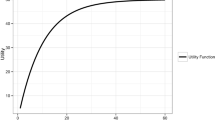Abstract
Experiments on intertemporal consumption typically show that people have difficulties in optimally solving such problems. Previous studies have focused on contexts in which agents are faced with risky future incomes and have to plan over long horizons. We present an experiment comparing decision making under certainty, risk, and ambiguity, over a shorter lifecycle. Results show that behavior in the ambiguity treatment is markedly different than in the risk condition and it is characterized by a significant pattern of under-consumption.

Similar content being viewed by others
Notes
Having set the discount rate equal to zero, \(\beta \) equals 1, so the same can be expressed by: \(E(U(c_t)+U(c_{t+1})+\cdots +U(c_T))\).
Starred variables indicate optimal choices.
The optimization programs were written using Maple.
This was omitted in the case of ambiguity.
Participants were also provided with tables showing some examples of conversions and of the interest mechanism.
Given our experimental design, the theoretical maximum utility corresponds to the maximum payment that subjects could achieve.
Here we refer to the “ex-post” optimum, i.e., the optimal solution calculated after income realizations.
The tables of the estimated planning horizons, relative to the three treatments, as well as the results of the statistical tests are available on request.
A table reporting optimal and average actual ratios (with their standard deviations) and deviations, is available on request.
Period 5 is not relevant because participants were clearly instructed that “leftovers” after the last periods would be lost.
Which was the case in this experiment as there was a fresh draw from the ambiguous bag after each round of each sequence.
References
Ballinger, T., Palumbo, M., & Wilcox, N. (2003). Precautionary saving and social learning across generations: An experiment. The Economic Journal, 113(490), 920–947.
Ballinger, T. P., Hudson, E., Karkoviata, L., & Wilcox, N. T. (2011). Saving behavior and cognitive abilities. Experimental Economics, 14(3), 349–374.
Brown, A., Chua, Z., & Camerer, C. (2009). Learning and visceral temptation in dynamic saving experiments. Quarterly Journal of Economics, 124(1), 197–231.
Browning, M., & Lusardi, A. (1996). Household saving: Micro theories and micro facts. Journal of Economic Literature, 34(4), 1797–1855.
Carbone, E., & Hey, J. (2004). The effect of unemployment on consumption: An experimental analysis. The Economic Journal, 114(497), 660–683.
Deaton, A. (1992). Understanding consumption (Clarendon Lectures in Economics). Oxford: Oxford University Press.
Fehr, E., & Zych, P. K. (1998). Do addicts behave rationally? Scandinavian Journal of Economics, 100(3), 643–662.
Fischbacher, U. (2007). z-tree: Zurich toolbox for ready-made economic experiments. Experimental Economics, 10(2), 171–178.
Hey, J. (2008). Exploring the experimental economics approach in pensions. Working Paper 43, Department for Work and Pensions.
Hey, J., & Dardanoni, V. (1988). Optimal consumption under uncertainty: An experimental investigation. The Economic Journal, 98(390), 105–116.
Stokey, N. L., Lucas, R. E., & Prescott, E. (1989). Recursive methods in economic dynamics. Cambridge: Harvard University Press.
Acknowledgments
We are grateful to John Hey for useful comments and suggestions.
Author information
Authors and Affiliations
Corresponding author
Rights and permissions
About this article
Cite this article
Carbone, E., Infante, G. Comparing behavior under risk and under ambiguity in a lifecycle experiment. Theory Decis 77, 313–322 (2014). https://doi.org/10.1007/s11238-014-9443-2
Published:
Issue Date:
DOI: https://doi.org/10.1007/s11238-014-9443-2




